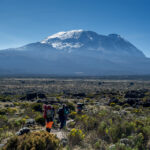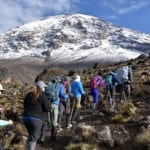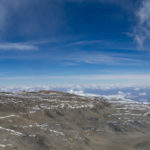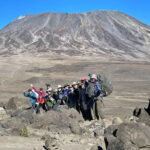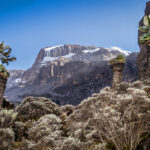
Nearing the summit!
Photo: Thomson Safaris guest, Tom Rohrer
Trekkers know that reaching Uhuru Peak won’t be easy; getting to the top involves long days of hiking, chilly nights, and some serious willpower. After all, it wouldn’t be such an amazing achievement if summiting weren’t a serious challenge!
But there’s one part of a Kilimanjaro hike that many people don’t fully prepare for (maybe because it’s not that much fun to talk about it): the ways that altitude can affect you on the mountain. Specifically, the effects it may have on your digestion.
Almost everyone will feel some mild symptoms of altitude on the mountain, and one of the most common problems trekkers have is occasional vomiting, diarrhea, or constipation. It’s hard enough to get to the top as-is; make sure you’re taking a few simple precautions in order to minimize your stomach symptoms on Kili:
Pack Ginger
Whether you bring it candied, in a lozenge, as an extract, or in whole-root form for easy gnawing, put ginger on the list of items you keep in your daypack. Ginger can help ease nausea and upset stomachs naturally, and munching a little on the trail can help prevent symptoms from worsening (or if you’re very lucky, starting in the first place).
We provide trekkers with ginger tea in camp, but you can do even more to alleviate symptoms by stashing your own and consuming it as needed throughout the day
Double-Check Your First-Aid Kit
Your safety is the number one priority of the guides and staff members on the mountain, but over-the-counter treatments such as Pepto-Bismol and Immodium should be in your personal first-aid kit. For many people, these are enough to deal with any stomach issues on the mountain.
Load Up on Good-For-You Food (and Water)
All our food on the mountain is hygienically prepared, and we provide trekkers with unlimited purified water throughout their treks—take advantage of this to help keep stomach issues at bay! Simple, plain foods, like crackers and unbuttered popcorn will be provided (and can keep a tender stomach from becoming more upset), and staying hydrated will not only keep you healthier, it can fight some of the symptoms of altitude.
Remember, it’s very important to eat and drink enough on the mountain, even if you are feeling a little off, which reminds us, you should make sure to…
Pack Your Absolute Favorite Treat
There will be more than enough healthy, hygienic food options on the mountain, but if you’re experiencing stomach troubles, sometimes a favorite food can help you get your appetite back. Whether it’s chocolate or Cheez-Its, a supply of your go-to guilty pleasure snack is a great way to help get your stomach back on track (or just reward yourself after a hard day’s hiking!) on the mountain.
Consider Diamox (a.k.a. Acetazolamide)
If you’re concerned about the effects of altitude, talk to your doctor before your trek, and consider whether a prescription for an altitude medication, such as Diamox, might be a good decision for you. You can either take these preemptively or as soon as you start feeling symptoms, and they can help greatly reduce the negative effects of altitude on your body.
Finally, maybe most importantly…
Mentally Prepare for a Bad Day
Chances are every trekker will have at least one rough day on the mountain; altitude just works that way. But if you follow these tips, and listen to your expert guides, you’ll likely be able to work through it. Often, trekkers will wake up the morning after a bad day feeling ready to get up and go!
So listen to your body, and do everything you can to keep symptoms at bay, but most importantly, remind yourself that feeling a little crummy occasionally is just part of a Kili trek…and it doesn’t mean you won’t still succeed in reaching the summit!

